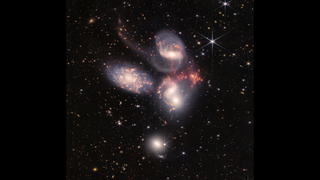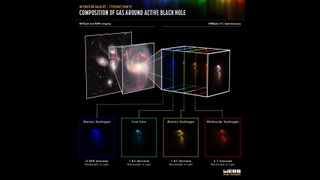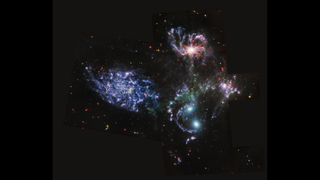The James Webb Space Telescope is on the hunt for the universe's 1st-ever supermassive black holes

Even NASA's next-generation space observatory can't manage to see supermassive black holes directly, but that doesn't mean astronomers can't use its data to better understand the mysterious behemoths.
The opportunities are even on display in the first science-quality images from the James Webb Space Telescope (nicknamed JWST or Webb) that NASA unveiled on July 12. Although supermassive black holes proper are invisible to all observatories that gather light, JWST will be able to observe the structures indirectly.
It has already, in fact. Consider the new portrait of five galaxies that appear to be locked in a cosmic dance. "The picture that we showed you of Stephan's Quintet is beautiful, and it tells you so many things in one picture," John Mather of NASA's Goddard Space Flight Center in Maryland, the senior program scientist for the James Webb Space Telescope, said during a news conference held on July 19 by the Committee on Space Research (COSPAR) in connection with its annual assembly, which was held last week in Athens.
Gallery: James Webb Space Telescope's 1st photos
In that image, astronomers can see a supermassive black hole, or rather, the light released by matter heating up and falling into the massive structure, which contains about 24 million times the mass of the sun, according to the Space Telescope Science Institute in Baltimore, which operates the observatory. (The black hole is also called an active galactic nucleus for its position at the heart of galaxy NGC 7319.)
The stunning image that NASA released combines snapshots taken by both the Near Infrared Camera (NIRCam) and the Mid-Infrared Instrument (MIRI). But JWST didn't just capture photographs. Both instruments also gathered what scientists refer to as data cubes, which incorporate both images and spectral analysis, a technique that identifies how much light of a given wavelength is coming from a source.
The results allowed scientists to pick apart the cloud surrounding the supermassive black hole, identifying how much of particularly interesting chemicals is located where. "We are testing out the environment of a black hole," Mather said of these observations. "We have now images of the shape of the hydrogen cloud, iron cloud, atomic hydrogen cloud, molecular hydrogen, as they are orbiting around or trying to fall into the gravitational field of the black hole."
Get the Space.com Newsletter
Breaking space news, the latest updates on rocket launches, skywatching events and more!

And, as was true of all the observations unveiled this month, the Stephan's Quintet observations came before the telescope had begun science operations in earnest; now, JWST has embarked on what astronomers hope will prove to be a 20-year tenure conducting groundbreaking science.
JWST's predecessor, the Hubble Space Telescope, has operated for more than 30 years and is still going strong, and that older observatory also contributed to scientists' understanding of supermassive black holes.
"Hubble was the first one to prove beyond a doubt that we have a black hole in the centers of galaxies, because they were able to observe the motion of stars orbiting quickly around a black hole," Mather said.

Webb will take that a few steps further, he noted. In particular, Mather said he hopes that JWST's observations will teach astronomers about the origins of active galactic nuclei, the supermassive black holes that lurk in every galaxy's core. "There is a giant black hole in the middle of every galaxy, and the origin of that black hole is completely unknown right now."
As scientists try to solve that mystery, they'll need to figure out when supermassive black holes arrived on the cosmic scene. Unlike Hubble, which sees most sharply in visible and ultraviolet wavelengths of light, the infrared-optimized JWST might be able to reach deep enough into the universe's history to observe a time before such structures existed.
"It's larger and can therefore see farther back in time and farther out in space, so we have more targets we can find," Mather said of the new observatory's capabilities compared to Hubble's. "We also get somewhat sharper images, and because the infrared is capable of penetrating dust clouds, we can see black holes much closer to the core."
And for Mather, understanding supermassive black holes isn't an idle pastime. He noted that the supermassive black hole at a galaxy's heart is a dominant player in the lives of everything else in the galaxy, in particular because the energy released by the behemoth sculpts the galaxy around it. That's no less true of our own Milky Way than of the distant galaxy in Stephan's Quintet.
"The history of the solar system would have been very different without the black hole in our galaxy," Mather said.
Email Meghan Bartels at mbartels@space.com or follow her on Twitter @meghanbartels. Follow us on Twitter @Spacedotcom and on Facebook.
Join our Space Forums to keep talking space on the latest missions, night sky and more! And if you have a news tip, correction or comment, let us know at: community@space.com.

Meghan is a senior writer at Space.com and has more than five years' experience as a science journalist based in New York City. She joined Space.com in July 2018, with previous writing published in outlets including Newsweek and Audubon. Meghan earned an MA in science journalism from New York University and a BA in classics from Georgetown University, and in her free time she enjoys reading and visiting museums. Follow her on Twitter at @meghanbartels.
